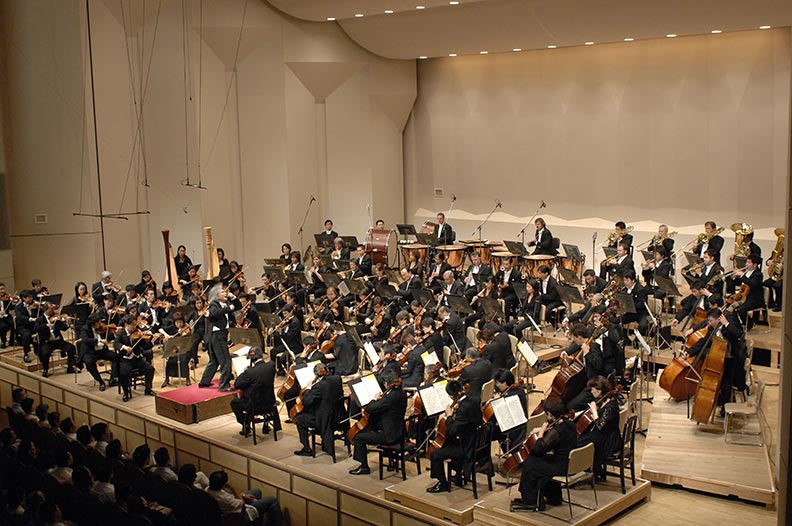The origin of SKO dates back to September 1984 when memorial concerts were held in remembrance of the great educator Hideo Saito on the tenth anniversary of his passing. Conductor Seiji Ozawa, who studied under Hideo Saito, organized more than a hundred of his fellow students including Kazuyoshi Akiyama for memorial concerts. This served as the foundation of what was to become SKO.
In 1987, SKO launched its first tour in Europe, followed by a second tour in 1989, and was lauded as “an astounding orchestra that arrived with Ozawa, whose performances were on par with the Vienna Philharmonic and Berlin Philharmonic.” In 1990, SKO under the baton of Seiji Ozawa was invited to festivals throughout Europe including the Salzburg Festival. In 1991, it embarked on a world tour with stops in London, Düsseldorf, Amsterdam, and New York. In 1992, Matsumoto City in Nagano Prefecture became the home of SKO, and the Seiji Ozawa Matsumoto Festival (formerly the Saito Kinen Festival Matsumoto) was launched.
Opera and concert performances that capture worldwide attention have been held since every year.
SKO members are key musicians of major orchestras, soloists, chamber musicians, and educators in Europe, America, and Japan, and many have won awards at international contests. Each player is full of unique musicality, but their approach towards music that could be considered the “Ozawa spirit” is fostered by participating in SKO and it is as if they merge to become one living creature. These exceptional features are passed on to young musicians of the next generation, giving this orchestra a distinctive presence in the world.
SKO has released many recordings to date, and in 2016 won the 58th Grammy Award for Best Opera Recording (Conductor Seiji Ozawa / Ravel L’enfant et les sortilèges). In 2022, for the joint “ONE EARTH MISSION” initiative with the Japan Aerospace Exploration Agency, SKO under the baton of Seiji Ozawa delivered a live orchestra performance to the International Space Station for the first time in history.

1984
The Memorial Concerts on the 10th anniversary of Hideo Saito’s death in Tokyo and Osaka were acclaimed as being of the highest caliber. Those concerts became the beginning of the career of the Saito Kinen Orchestra.
1987
The Saito Kinen Orchestra made their first official tour of Europe. Their concerts in Vienna, Berlin, London, Paris, and Frankfurt won the highest of praise.
1989
During the second tour, the Orchestra recorded Brahms’ Symphony No.4 as well as Toru Takemitsu’s November Steps for Philips Classics.
1990
Under Seiji Ozawa, the Orchestra was invited to many prestigious European festivals such as the Salzburg Festival. During the tour, the Orchestra recorded Brahms’ Symphony No.1 and Takemitsu’s Viola Concert.
1991
The Saito Kinen Orchestra performed in London, Düsseldorf, Amsterdam and New York. They made their U.S. debut at the opening concert of Carnegie Hall's 101st season.
1992
The Saito Kinen Orchestra became the centerpiece to Seiji Ozawa’s first annual, world-class Saito Kinen Festival Matsumoto, located in the Japan Alps. The overwhelmingly successful event included a production of Stravinsky's Oedipus Rex.
1993
The second Festival featured a full production of Honegger’s Jeanne d’ Arc au bücher (Joan of Arc), a concert version of Schoenberg’s Verklärte Nacht (Transfigured Night).
1994
Another tour of Europe (Salzburg, Athens and Cologne). The Saito Kinen Festival Matsumoto offered memorable performances of Verdi's Requiem.
1995
The centerpiece consisted of a staged production of Stravinsky’s The Rake’s Progress.
1996
The Festival included a special commemorative performance of My Way of Life in tribute to the recently departed Toru Takemitsu, spiritual pillar of the Festival.
1997
The Saito Kinen Orchestra made their sixth tour to Europe in April. For the Festival, the ensemble performed the St. Matthew-Passion by J.S.Bach.
1998
The Festival had their first co-production with l'Opera National de Paris in highway acclaimed performance of Dialogues des Carmélites by Poulenc.
1999
The Saito Kinen Orchestra again jointly produced La Damnation de Faust, by Berlioz, with l’Opera National de Paris. The Festival’s program included guest appearances by pianist Mitsuko Uchida and an all-Beethoven performance.
2000
The Saito Kinen Orchestra presented Special Winter Concert. The Orchestra performed Mahler’s Symphony No.2, “Resurrection” in Matsumoto as well as Tokyo.
2001
During the 10th anniversary Festival, the performances with The Boys Choir of Harlem added further to the highlights such as the production of the opera Jenufa.
2002
The Saito Kinen Orchestra wrapped up their Beethoven series with the 9th Symphony and they again welcomed Rostropovich. Benjamin Britten’s opera, Peter Grimes, was co-produced with Teatro del Maggio Musicale Fiorentino.
2003
In 2003, Verdi’s opera Falstaff was performed. The Orchestra program included Bruckner’s Symphony No. 7 in E major.
2004
In May, the Orchestra embarked on a third European Tour. The Festival welcomed Kazushi Ono as a guest conductor. For the opera, Alban Berg’s Wozzeck was presented.